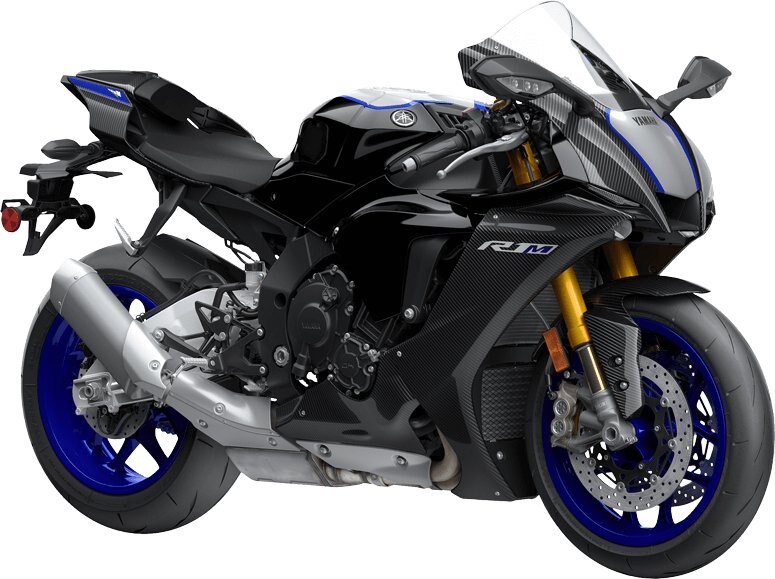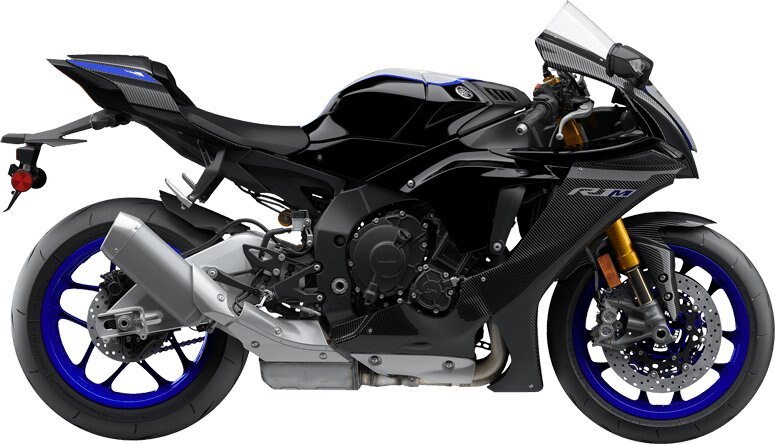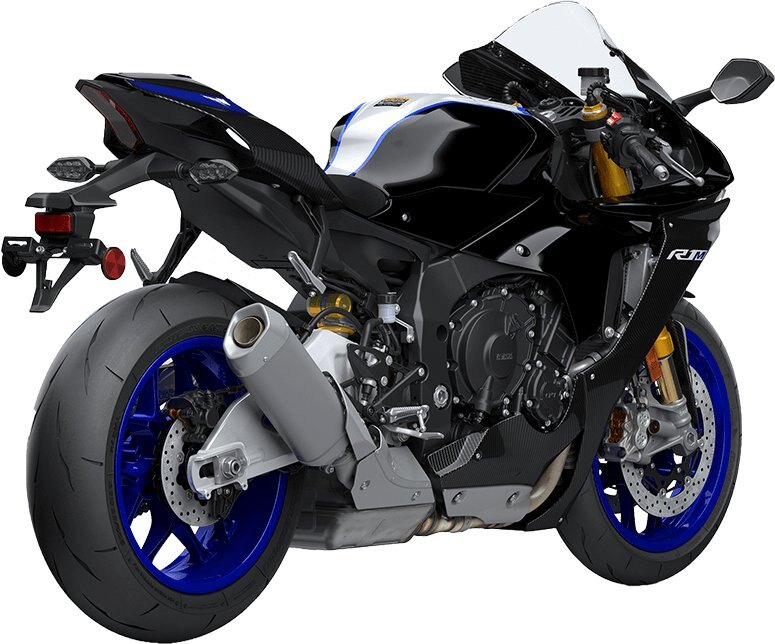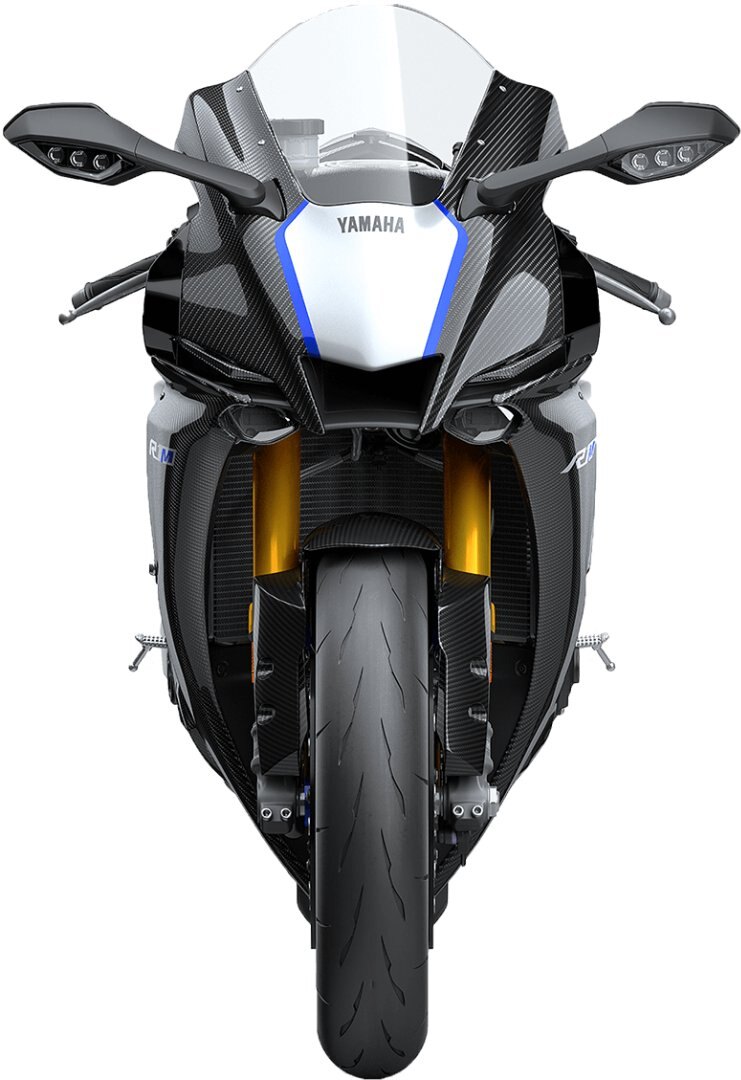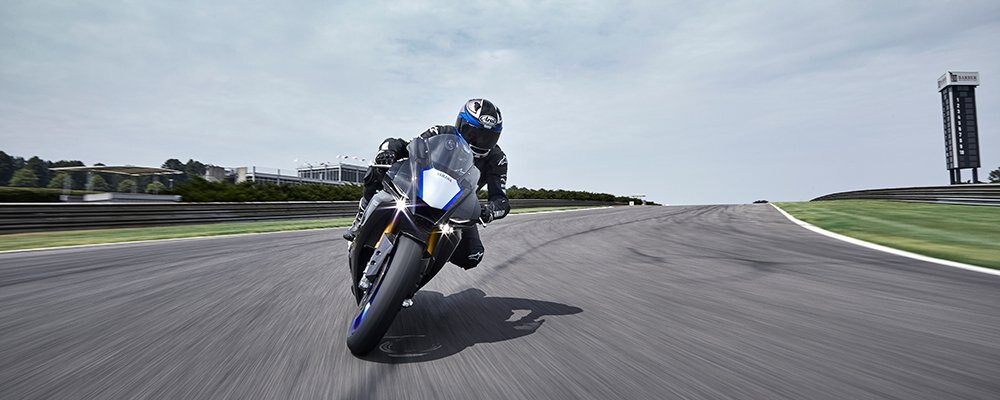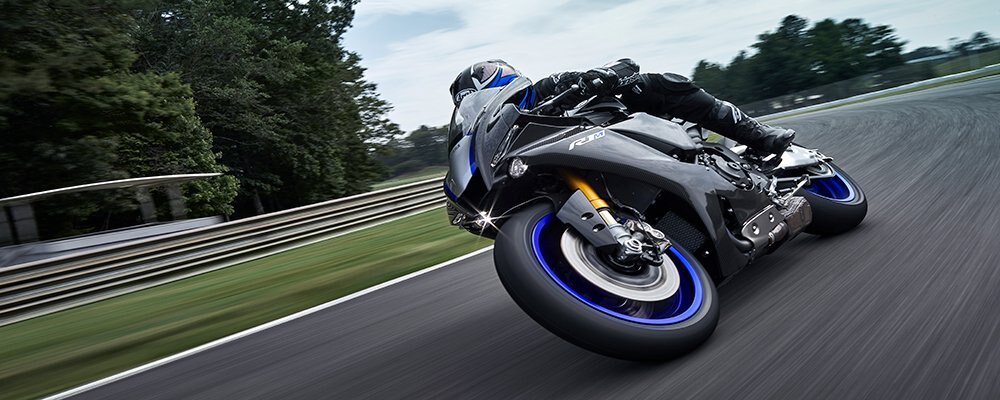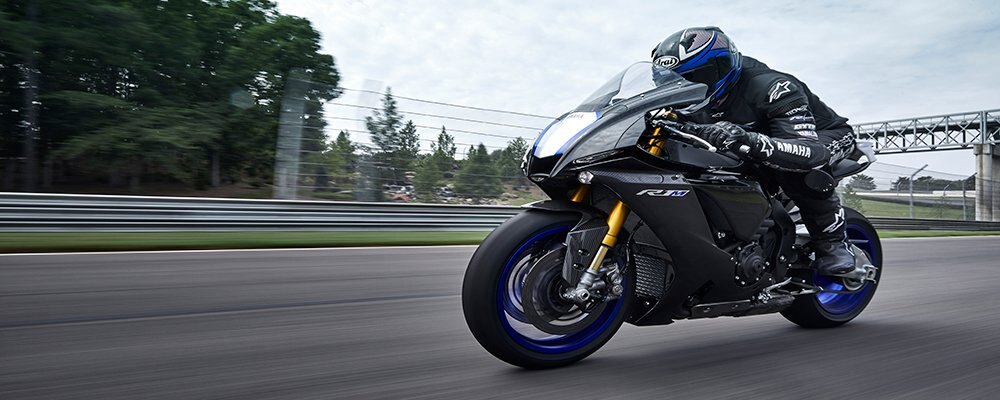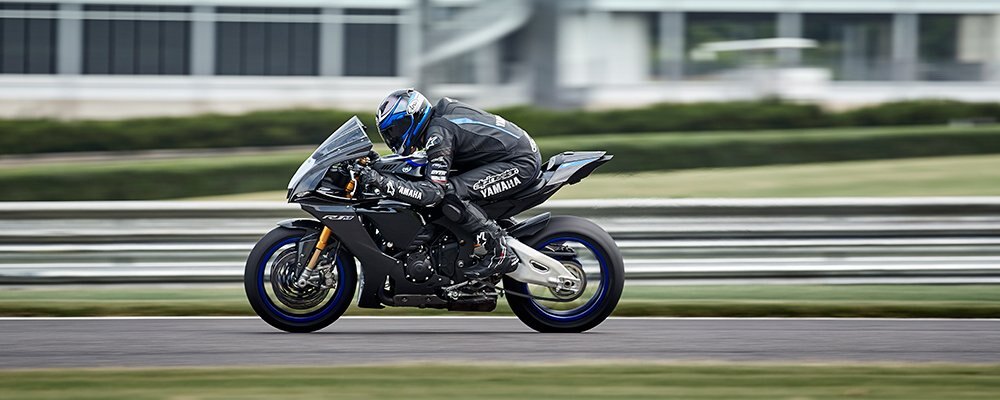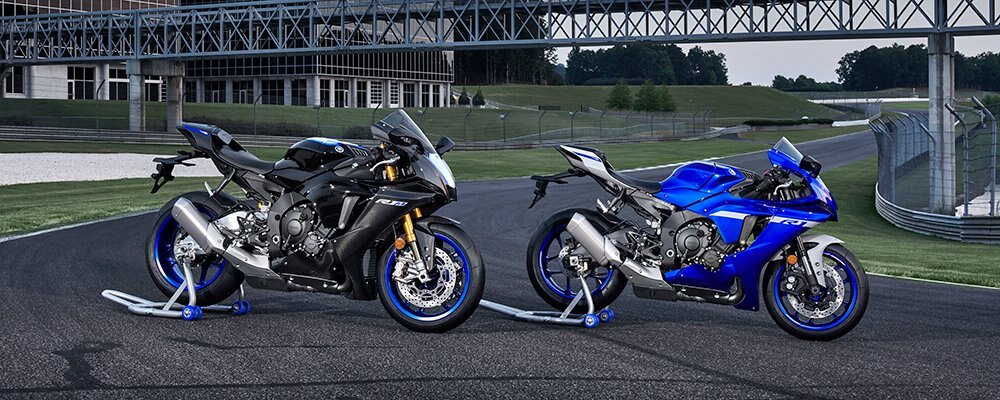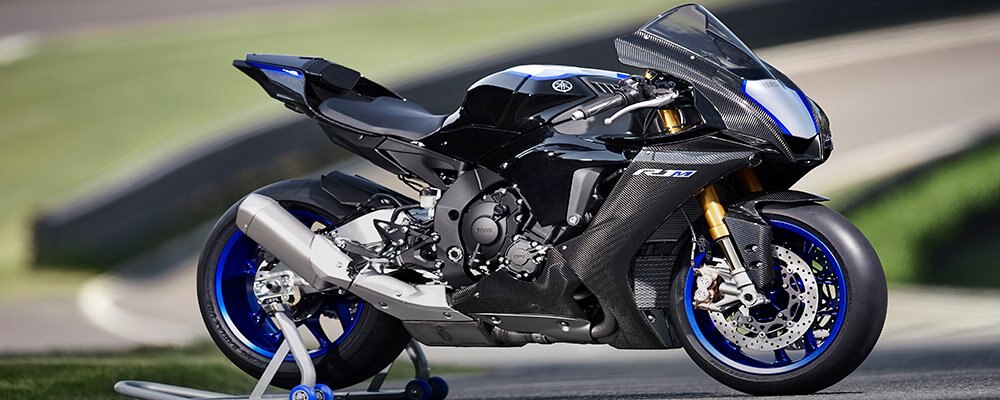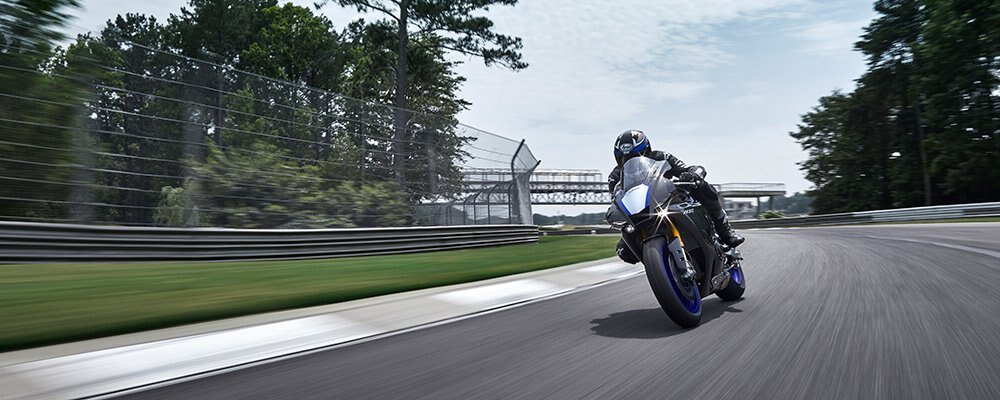|
Model |
YZF-R1M |
|
Category Name |
Motorcycles |
|
Year |
2020 |
|
Sale Type |
New |
|
Manufacturer |
Yamaha |
|
Quantity |
0 |
|
Manufacturer Qty |
0 |
|
Color |
Blue |
|
Engine Size |
998 cc |
|
Transmission |
6-speed |
|
Length |
2,055 mm (80.9'') |
|
Width |
690 mm (27.2'') |
|
Height |
1,150 mm (45.3'') |
|
Engine |
Liquid-cooled, DOHC, 16-valves (4-valves / cyl), in-line four |
|
Bore And Stroke |
79 x 50.9mm |
|
Compression Ratio |
13: 1 |
|
Ignition / Starting |
TCI / Electric |
|
Final Drive |
520 series ''O'' ring chain |
|
Wheelbase |
1,405mm (55.3'') |
|
Ground Clearance |
130 mm (5.1'') |
|
Fuel Capacity |
17 litres (3.7 Imp. gal.) |
Comments |
|
CONQUER ROAD
Yamaha has a rich heritage of building the most sought-after supersport motorcycles designed to deliver the pinnacle of performance on and off the track. Based on the legendary YZF-R1, the 2020 R1M goes a step above: standard features include premium Öhlins Electronic Racing Suspension (ERS), a standard Communication Control Unit (CCU) for data and lap time acquisition with your smartphone, and carbon fibre bodywork. From crossplane crankshaft engines to revolutionary electronics such as the six-axis Inertial Measurement Unit (IMU), Yamaha's historical achievements have become the future of R World. |
SUSPENSION

Premium Öhlins Electronic Racing Suspension (ERS) has been a staple of the R1M's chassis performance, and a new NPX pressurized front fork with a gas cylinder built into the front fork axle bracket, along with revised rear shock settings to complement the performance of the front fork, are features of the new 2020 model. With rider adjustability options through YRC settings and Y-TRAC, the new Öhlins ERS suspension package takes the R1M to the next level of performance. |
|
THE FINEST MATERIALS
Carbon fibre, magnesium and titanium are used throughout the R1M for quality, light weight and performance. Titanium connecting rods are 60 percent lighter than conventional steel to reduce horsepower losses and provide faster throttle response. The R1M's wheels, oil pan, cylinder head cover and crankcase covers are all made of magnesium, while a new carbon fibre tail cowl accompanies the existing carbon fibre front fender, fairing and passenger seat cowl.
 |
|
ELECTRONIC RIDER CONTROLS
The R1M is stacked with electronic rider aids. New Brake Control (BC) and Engine Braking Management (EBM) technology joins a robust package that includes power modes, traction control, slide control, lift control, launch control and quickshifting. These systems can be individually manipulated to the rider's preference on the R1M's TFT screen.
 |
|
KEY DIFFERENCES BETWEEN R1M & R1 |
- Premium Öhlins Electronic Racing Suspension (ERS)
- Communication Control Unit (CCU) - Datalogger & vehicle info via Wi-Fi (standard equipment)
- Wider 200 series rear tire (200/55ZR17)
- Carbon fibre bodywork
|
|
NEW FOR 2020 |
- Redesigned cylinder head, fuel injectors, finger-follower rocker arms and camshaft profiles
- New ride-by-wire system with YCC-T
- Brake Control (BC) and Engine Brake Management (EBM) for a total of seven electronic control rider aids
- Öhlins ERS NPX front fork with integrated gas cylinder and optimized rear shock settings
- Next-generation R-Series redesigned bodywork with outstanding aerodynamic efficiency
- Carbon fiber tail cowl
- Bridgestone RS11 Battlax Racing Street tires with updated tread design
- New front brake pad friction material for excellent control while braking
|
|
ELECTRONIC RIDER AIDS... YRC |
Many of the following rider assist aids are derived from Yamaha's MotoGP race efforts and help make the R1 more controllable & more enjoyable to ride. We call them Yamaha Ride Control or YRC.
- At the heart of the "Yamaha Ride Control" electronic rider assist aids are the IMU or Inertial Measurement Unit & ECU. The IMU features six axis of measurement using a gyro sensor to detect rotational motion in the pitch, roll & yaw directions. A "G" sensor detects acceleration / velocity in the forward & back, up & down and left & right directions. The vehicle position information obtained from the two sensors including bank angle, pitch rate & sideways slide acceleration is sent to the ECU which in turn controls the five YRC systems (not including the quick shift system). These variables are calculated 125 times per second.
-
PWR: Power Delivery Mode is Yamaha's variable throttle control, which controls the throttle valve opening speed, enabling the rider to adjust performance characteristics of the engine based on riding preferences or riding / racing conditions. There are 4-power settings available from an enhanced race setting to a slippery condition mode with softer power characteristics.
-
TCS: Traction control system with lean angle sensor. System uses front & rear wheel sensors to detect slip & then adjusts / regulates power via the ECU / IMU to control rear wheel spin. In addition to detecting difference in speed between the front & rear wheels, the system uses input on the degree of bank / lean angle to adjust the degree of TCS intervention to an optimum level in relation to riding conditions in real-time. As the banking angle increases, the amount of TCS intervention also increases. When the TCS is disabled, SCS, LIF & LCS systems will automatically be shut down as well. There are 9 settings plus off.
-
SCS: Slide Control System controls engine power when side slip is detected. Power output is adjusted to an optimum level to control side slide. There are 3 settings plus off.
-
LIF: Lift Control System (a.k.a. anti-wheelie control) reduces time loss due to wheelies during closed course competition. System reduces front end lift during starts & hard acceleration. When the IMU and other sensors detect lift, engine output is adjusted to the optimum level to maintain strong acceleration without lift. There are 3 settings plus off.
-
LCS: Launch Control System is adopted to help ensure fast, strong, controllable starts in closed course competition situations. When the LCS is activated, it keeps engine rpm limited to approx. 10,000 rpm & maintains an optimum level of engine power in conjunction with inputs from the TCS and LIF systems, allowing the rider to concentrate on clutch engagement & other competitors, reducing stress associated with race starts. There are 2 settings plus off.
-
QSS: Quick Shift System provides smooth, fast upshifts even at full throttle. When the switch on the shift lever rod detects motion, it adjusts engine output & momentarily cancels out the drive torque to promote faster gear shifts. There are 2 settings plus off. System can be adapted to race shift pattern.
-
Accessory ready Communication Control Unit (CCU):
-
- CCU is Yamaha's data acquisition unit ... a great tool for track day & race enthusiasts
- works with IOS & Android platforms
- parameters recorded include: traction-control activation, front & rear ABS activation, lean angle, vehicle speed, engine rpm, wheel speeds, throttle position, gear position, front & rear brake pressures, coolant temperature and lap times
- information in conjunction with position on the race track
- possible to overlay multiple laps & share data with other R1 riders
|
|
|
CHASSIS/SUSPENSION |
-
Gravity cast, aluminum Deltabox frame.
- designed to offer an optimized rigidity balance to maximize handling & suspension performance. Frame provides a balance of strength, rigidity & tuned flex
- engine is stressed member with rigid mounts
- benefits include reduced weight, excellent high-speed stability & cornering characteristics, excellent traction / drive characteristics exiting a corner and a greater freedom in choosing or changing a line through a turn
-
Detachable magnesium cast rear subframe.
- reduces weight
- allows easier rear shock access & reduces costs in the event of damage
-
Lightweight aluminum "upward truss-type" swingarm.
- provides great torsional rigidity for excellent rear wheel traction & control
- swingarm length is 570 mm
- design & length help reduce effects of chain tensioning during hard acceleration
-
Key chassis geometry figures:
- 1405 mm wheelbase, 24 degree caster angle, 102 mm of trail
- 56 degree maximum lean
-
Fully adjustable KYB 43mm inverted fork with 120 mm (4.7") of wheel travel.
- adjustments include 15 turns of spring preload, 14-way rebound & 23-way compression damping
- incredible suspension performance with excellent "feedback"
- inverted design reduces unsprung weight & increases the rigidity of the fork since the larger diameter tubes are gripped in the triple clamps
- adjustable design allows the rider to tune suspension to match riding style, rider weight & road or track conditions
-
Fully adjustable Monocross link rear suspension utilizes a piggyback-style KYB shock providing 120mm (4.7") of wheel travel.
- shock adjustments include: 8 mm of treaded spring preload, 23-way rebound damping, 18-way slow speed compression damping and 5.5 turns of high speed compression damping
- overall shock length can be adjusted by 5 mm for ride height adjustability
- piggyback design helps to keep the shock oil cool for more consistent damping
-
Electric steering damper
-
ABS equipped, radial mount, 4-piston, mono-block calipers squeeze fully floating 320mm dual front discs.
- incredible braking performance with excellent control & lever feedback
- radial mount design helps to reduce caliper distortion for improved braking performance
- Nissin radial master cylinder
- stainless steel mess brake lines
- 6-position adjustable brake lever
-
Single piston, slide-type Nissin rear caliper squeezes a lightweight 220mm disc.
-
Front & rear brakes feature Yamaha's latest anti-lock brake (ABS) & variable unified brake (UBS) technology.
- main benefit of ABS is excellent control under hard braking or braking on wet or slippery surfaces
- when ABS system senses impending wheel lock-up (via active type wheel sensors) it regulates the hydraulic brake pressure to the point just before the wheel(s) lock-up
- UBS system "unifies or links" the front & rear brakes when the front brake is applied
- applying the front brake will engage the UBS and to a varying degree will apply some rear brake force too. The amount of rear brake force is based on the attitude & lean angle of the bike.
- if only the rear brake is applied, the UBS will not apply any front wheel brake force
-
Super lightweight, die cast magnesium 10-spoke mag wheels.
- over 1 kg of weight savings Vs. the 2014 wheels (last generation)
- lightweight contributes to excellent suspension (reduced unsprung weight) & handling performance
- front rim size is MT3.50 x 17, rear rim is MT6.00 x17
-
Lightweight 17 litre aluminum fuel tank.
- tank provides excellent knee grip for hard braking & easy manoeuvrability
- elongated shape helps to centralize mass & reduces variance in riding feel as the fuel load (weight) changes
- 3 litre reserve capacity (fuel trip meter activates)
-
Eye caching front fairing & windscreen provide a striking YZR-M1 race bike image.
- wind tunnel designed windshield offers excellent aerodynamics & features a "screw less" design
- air resistance (fairing design) has been reduced by 8% compared to the '14 model (last generation)
-
LED headlights & high intensity LED position lights.
- create a "face" never seen before on a motorcycle & provides stylish & unique look for the R1
- excellent illumination & visibility
- reduced power consumption
-
Fully digital instrument panel with TFT liquid crystal display.
- displays have been concentrated into a single 4.2-inch screen that adopts a fully transmissive Thin Film Transistor (TFT) liquid crystal display that reduces reflection & glare
- white or black backgrounds can be selected
- auto brightness adjustment based on available ambient light
- 2-modes are available... street & track
- street display mode functions include; speedo, bar style tach, odometer, dual trip meters, gear position, intake air temp, coolant temp, instant & average fuel efficiency, clock, fuel consumed, fuel trip meter (appears when fuel switches to reverse - 3 litres remaining), peak rpm indicator, front brake pressure indicator, acceleration indicator, lap timer & selected YRC setting info
- track mode functions include; race tach setting (tach starts at 8,000 rpm), lap number, lap timer, stop watch, gear position, speed & most of the above street displays including YRC setting info
-
Immobilizer ignition system is designed to reduce the possibility of "ride away" theft.
- system must recognize the "coded ignition key" in order for the unit to start
- if the immobilizer ignition does not recognize the key, the ignition system & starter will not function, even if the ignition is forced into the on position
|
|
DETAILS |
- LED front turn signals integrated into mirrors
- LED tail light & compact LED rear turn signals
- 12 volt auxiliary DC connector (24 W / 2A)
- Large 25mm hollow front axle
- Extensive use of lightweight fasteners
- Lightweight 525 series "O" ring drive chain
- Oil level sight glass window
- Low maintenance, lightweight, sealed battery (battery should be charged during winter storage)
|
|
NOTE: The YZF-R1 offers a significant level of power and performance. It is not intended for novice or inexperienced riders. All information is subject to change without notice. |
| |
